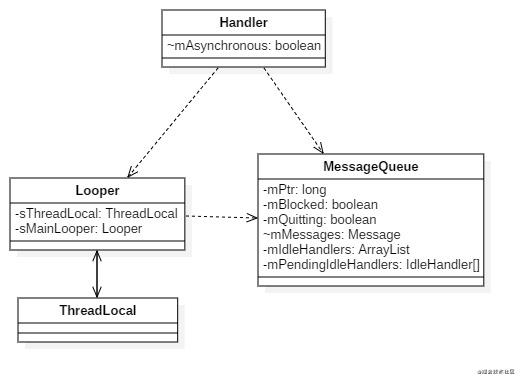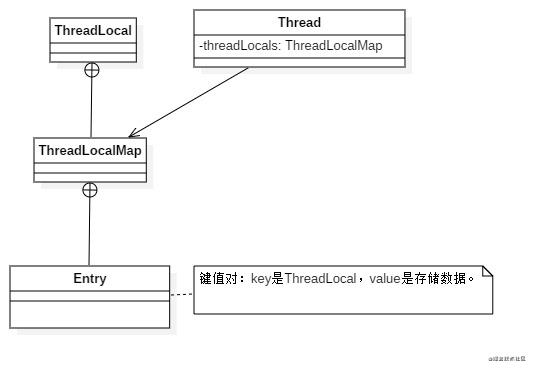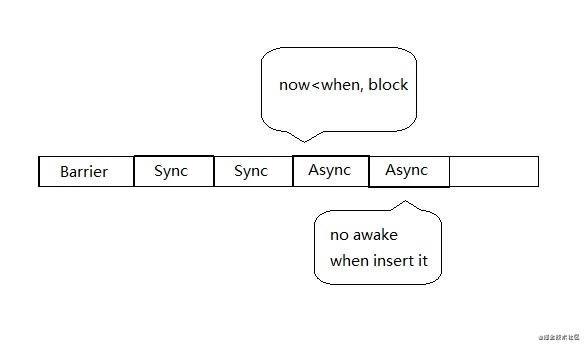详解Android Handler的使用
Handler
概要
构造器
sendMessageAtTime
dispatchMessage
ThreadLocal
Looper
MessageQueue
IdleHandler
AsyncMessage和SyncBarrier
阻塞和唤醒机制
Handler内存泄漏分析
Handler 概要Handler用于线程间的消息传递,它可以将一个线程中的任务切换到另一个线程执行。切换的目标线程与Handler内部持有的Looper所在线程一致。若初始化Handler时未手动设置Looper,Handler会通过ThreadLocal获取并持有当前(初始化Handler时)线程的Looper。当Handler发送一条消息后,这条消息会进入目标线程的MessageQueue,目标线程的Looper扫描并且取出消息,最终由Handler执行这条消息。

Handler的构造器大致分为以下两种:
public Handler(Callback callback, boolean async){}
public Handler(Looper looper, Callback callback, boolean async){}
构造器的参数列表:
callback:Handler处理消息的接口回调,执行消息时可能会调用该接口。
async:默认false,若该值为true,则消息队列中的所有消息均是AsyncMessage。AsyncMessage的概念请看后续章节。
looper:消息的查询者,会不断轮询检查MessageQueue是否有消息。
若调用者传递Looper,直接使用该Looper;否则通过ThreadLocal从当前线程中获取Looper。所以执行任务所在的目标线程不是创建Handler时所在的线程,而是Looper所在的线程。
sendMessageAtTime无论是使用post(Runnable r)还是sendMessage(Message m)发送消息,最终都会执行到sendMessageAtTime方法。该方法指定了Message的执行者(msg.target=handler)和调用时机(msg.when)。
dispatchMessagedispatchMessage方法用于执行事先注册的Message和Handler回调,源码如下:
public void dispatchMessage(Message msg) {
if (msg.callback != null) {
handleCallback(msg);
} else {
if (mCallback != null) {
if (mCallback.handleMessage(msg)) {
return;
}
}
handleMessage(msg);
}
}
可以发现回调的优先级是:Message的回调>Handler的回调(构造器章节中的callback)>Handler子类重写的handleMessage方法。
ThreadLocalThreadLocal是一个线程内部的数据存储类,用于存放以线程为作用域的数据,在不同的线程中可以持有不同的数据副本。通过ThreadLocal就可以很方便的查找到当前线程的Looper。ThreadLocal内部实现的UML类图如下:

通过ThreadLocal查找Looper的流程如下:
通过Thread.currentThread()获取当前线程对象。
取出线程对象持有的ThreadLocalMap对象。
以自身为key,获取ThreadLocalMap中对应Entry的value。
LooperLooper在Handler中扮演着消息循环的角色。它会不断查询MessageQueue中是否有消息。当没有消息时Looper将一直阻塞。
若当前线程没有Looper,且调用者未传Looper,Handler会因为未获取Looper而报错。解决办法是通过Looper.prepare在当前线程手动创建一个Looper,并通过Looper.loop开启消息循环:
new Thread("Thread#2") {
@override
public void run() {
Looper.prepare();
Handler handler = new Handler();
Looper.loop();
}
}
Looper提供了quit和quitSafely两种方式来退出一个Looper。区别在于前者会直接退出;后者则是在处理完消息队列的已有消息后才安全退出。
Looper所在的线程会一直处于运行状态,所以建议消息处理完毕后及时退出Looper,释放线程。
MessageQueueMessageQueue是消息的存储队列,内部提供了很多精彩的机制。
IdleHandlerIdleHandler本质上只是一个抽象的回调接口,没有做任何操作:
/**
* Callback interface for discovering when a thread is going to block
* waiting for more messages.
*/
public static interface IdleHandler {
/**
* Called when the message queue has run out of messages and will now
* wait for more. Return true to keep your idle handler active, false
* to have it removed. This may be called if there are still messages
* pending in the queue, but they are all scheduled to be dispatched
* after the current time.
*/
boolean queueIdle();
}
看上述注释可以了解,MessageQueue会在将要进入阻塞时执行IdleHandler的queueIdle方法,队列阻塞的触发时机是:
消息队列没有消息。
队首消息的执行时间大于当前时间。
当我们希望一个任务在队列下次将要阻塞时调用,就可以使用IdleHandler。在Android工程中最常见的例子就是:给Activity提供生命周期以外的回调。
比如我希望在布局绘制完成后执行某个操作,但是Activity的onStart和onResume回调均在View绘制完成之前执行,可以看看onResume的官方注释:
/**
* ...
* <p>Keep in mind that onResume is not the best indicator that your activity
* is visible to the user; a system window such as the keyguard may be in
* front. Use {@link #onWindowFocusChanged} to know for certain that your
* activity is visible to the user (for example, to resume a game).
* ...
*/
@CallSuper
protected void onResume() {...}
这种情况下就可以给MessageQueue设置一个IdleHandler,等当前队列中的消息(包括绘制任务)执行完毕并将要进入阻塞状态时,调用IdleHandler的任务,确保任务在绘制结束后执行。
使用方式如下所示:
if (Build.VERSION.SDK_INT >= Build.VERSION_CODES.M) {
Looper.myLooper().getQueue().addIdleHandler(new MessageQueue.IdleHandler() {
@Override
public boolean queueIdle() {
// do something when queue is idle
// 返回值表示bKeepAlive标识:true->继续使用,false->销毁该Handler
return false;
}
});
}
AsyncMessage和SyncBarrier顾名思义,SyncBarrier表示同步栅栏(也叫作障碍消息),用于阻塞SyncMessage,优先执行AsyncMessage。该机制大大提升了MessageQueue的操作灵活性。
在进一步了解这两个概念之前,需要先了解MessageQueue插入消息的机制,MessageQueue的enqueueMessage源码如下(省略了唤醒队列的相关代码):
boolean enqueueMessage(Message msg, long when) {
synchronized (this) {
msg.markInUse();
msg.when = when;
Message p = mMessages;
if (p == null || when == 0 || when < p.when) {
// New head.
msg.next = p;
mMessages = msg;
} else {
// Inserted within the middle of the queue.
Message prev;
for (;;) {
prev = p;
p = p.next;
if (p == null || when < p.when) {
break;
}
}
msg.next = p; // invariant: p == prev.next
prev.next = msg;
}
return true;
}
从上述源码可知,消息按照调用时机(when)有序排列,当when等于0时,直接将消息插在队头;当when等于队列中消息的when时,将消息插在这些消息的后方。
假设这样一个场景:我们有一个非常紧急的任务,希望能够优先执行,该如何处理?
很简单,发送一个when为0的消息,它将自动被插到列表的头部。Handler中也提供了现成的接口:
public final boolean postAtFrontOfQueue(Runnable r)
{
return sendMessageAtFrontOfQueue(getPostMessage(r));
}
public final boolean sendMessageAtFrontOfQueue(Message msg) {
return enqueueMessage(queue, msg, 0);
}
将场景升级一下:我们有一个任务A,其他所有任务都依赖于A,若A未执行,则其他所有任务都不允许执行。
A插入队列的时间和执行时间都是不确定的,在此之前,所有任务都不允许执行。按照当前的机制无法实现该需求,此时SyncBarrier和AsyncMessage就派上了用场,实现流程如下:
调用MessageQueue.postSyncBarrier将SyncBarrier插入队列:SyncBarrier本质上是一个target为空的消息,插入逻辑和普通消息一致,也是按照when确定插入位置。SyncBarrier的when固定是SystemClock.uptimeMillis(),因此将其插入到队列的中间(SyncBarrier前面可能会有一些无时延的消息,后面可能会有带时延的消息)。
插入SyncBarrier后,轮询消息直至SyncBarrier排到队列头节点,此时使用next方法查询消息将自动过滤同步消息,只执行异步消息。源码如下所示:
// mMessages表示队首消息
Message msg = mMessages;
if (msg != null && msg.target == null) {
// Stalled by a barrier. Find the next asynchronous message in the queue.
do {
prevMsg = msg;
msg = msg.next;
} while (msg != null && !msg.isAsynchronous());
}
插入任务A(将A定义为AsyncMessage),由于SyncBarrier的存在,A将优先被执行(不排除A有时延,此时队列将进入阻塞状态,即便队列里可能存在无时延的同步消息)。
只要SyncBarrier放在队首,同步消息将一直被阻塞,消息队列只能输出AsyncMessage。当任务A执行完毕后,需要调用removeSyncBarrier手动将SyncBarrier移除。
Handler提供了接口让我们插入AsyncMessage,即构造器中的asyc参数。当async为true时,所有通过Handler传递的消息均会被定义为AsyncMessage(前提是要和SyncBarrier配合使用,不然AsyncMessage没有效果)。
再重新思考SyncBarrier和AsyncMessage机制的应用场景,本质上就是为了阻塞从Barrier消息到AsyncMessage消息之间的同步消息的执行。
在Android源码中,布局的绘制就使用了这种机制。在ViewRootImpl的scheduleTraversals方法中,会事先往主线程的消息队列设置Barrier,再去提交AsyncMessage,阻塞在此期间的所有同步消息。源码如下:
void scheduleTraversals() {
if (!mTraversalScheduled) {
mTraversalScheduled = true;
// 设置Barrier
mTraversalBarrier = mHandler.getLooper().getQueue().postSyncBarrier();
// 该方法最终会提交一个AsyncMessage
mChoreographer.postCallback(
Choreographer.CALLBACK_TRAVERSAL, mTraversalRunnable, null);
if (!mUnbufferedInputDispatch) {
scheduleConsumeBatchedInput();
}
notifyRendererOfFramePending();
pokeDrawLockIfNeeded();
}
}
阻塞和唤醒机制Tips:关于Barrier的概念在Java并发中多有涉及,比如CountDownLatch、CyclicBarrier等。详情请查看《Thinking in Java》21.7章节。
阻塞和唤醒机制是MessageQueue的精髓,极大降低了Loop轮询的频率,减少性能开销。
在IdleHandler章节已经提及MessageQueue阻塞的时机:
消息队列没有消息。
队首消息的执行时间大于当前时间。
next方法的源码如下:
Message next() {
int nextPollTimeoutMillis = 0;
for (;;) {
if (nextPollTimeoutMillis != 0) {
Binder.flushPendingCommands();
}
// 关键方法,将线程阻塞nextPollTimeoutMillis毫秒,若nextPollTimeoutMillis为-1,线程将一直处于阻塞状态。
nativePollOnce(ptr, nextPollTimeoutMillis);
synchronized (this) {
// Ignore SyncBarrier code
final long now = SystemClock.uptimeMillis();
Message prevMsg = null;
Message msg = mMessages;
if (msg != null) {
if (now < msg.when) {
// Next message is not ready. Set a timeout to wake up when it is ready.
nextPollTimeoutMillis = (int) Math.min(msg.when - now, Integer.MAX_VALUE);
} else {
// Got a message.
mBlocked = false;
if (prevMsg != null) {
prevMsg.next = msg.next;
} else {
mMessages = msg.next;
}
msg.next = null;
msg.markInUse();
return msg;
}
} else {
// No more messages.
nextPollTimeoutMillis = -1;
}
// Ignore IdleHandler code
if (pendingIdleHandlerCount <= 0) {
// No idle handlers to run. Loop and wait some more.
mBlocked = true;
continue;
}
}
}
}
插入消息时唤醒MessageQueue的时机(假设队列处于阻塞状态):
队首插入一条SyncMessage。
队首是一个栅栏,且插入一条离栅栏最近的AsyncMessage。
enqueueMessage方法的源码如下:
boolean enqueueMessage(Message msg, long when) {
synchronized (this) {
msg.markInUse();
msg.when = when;
Message p = mMessages;
boolean needWake;
if (p == null || when == 0 || when < p.when) {
// New head, wake up the event queue if blocked.
msg.next = p;
mMessages = msg;
needWake = mBlocked;
} else {
// Inserted within the middle of the queue. Usually we don't have to wake
// up the event queue unless there is a barrier at the head of the queue
// and the message is the earliest asynchronous message in the queue.
needWake = mBlocked && p.target == null && msg.isAsynchronous();
Message prev;
for (;;) {
prev = p;
p = p.next;
if (p == null || when < p.when) {
break;
}
if (needWake && p.isAsynchronous()) {
needWake = false;
}
}
msg.next = p; // invariant: p == prev.next
prev.next = msg;
}
// We can assume mPtr != 0 because mQuitting is false.
if (needWake) {
// 关键方法,用于唤醒队列线程
nativeWake(mPtr);
}
}
return true;
}
唤醒的第二种时机特意强调了插入离Barrier最近的AsyncMessage。对于如下的阻塞情况,插入AsyncMessage时不需要将其唤醒:

了解了Handler的内部原理后,再来分析由Handler引起的内存泄露问题:
当定义了一个非静态的Handler内部类时,内部类会隐式持有外围类的引用。
Handler执行sendMessageAtTime方法时,Message的target参数会持有Handler对象。
当Message没有被执行时(比如now<when),若退出了Activity,此时Message依然持有Handler对象,而Handler持有Activity的对象,导致内存泄露。
解决方案:
将Handler定义为静态内部类。
退出Activity时清空MessageQueue中对应的Message。
以上就是详解Android Handler的使用的详细内容,更多关于Android Handler的资料请关注软件开发网其它相关文章!